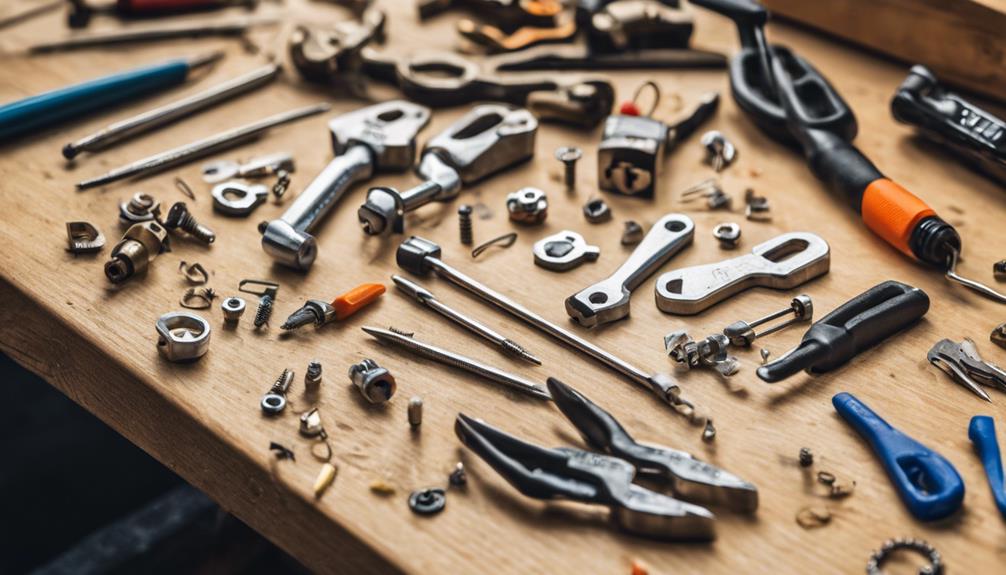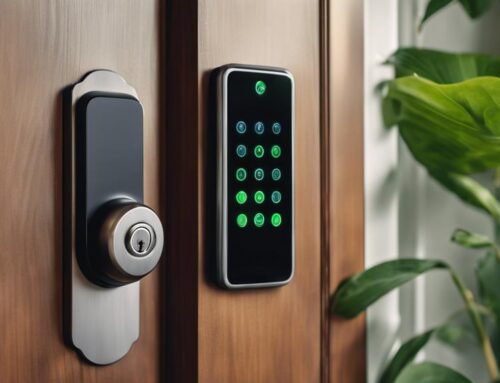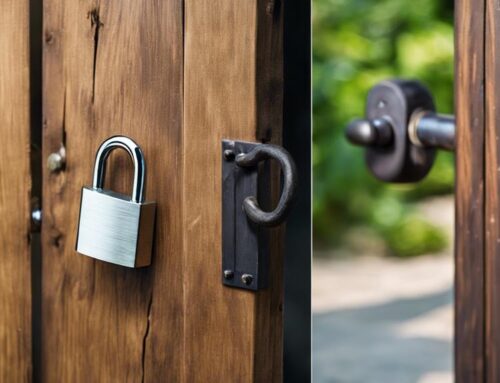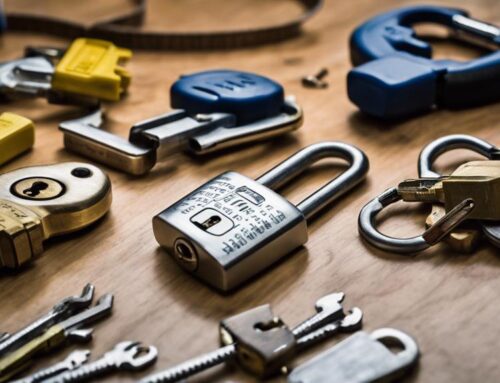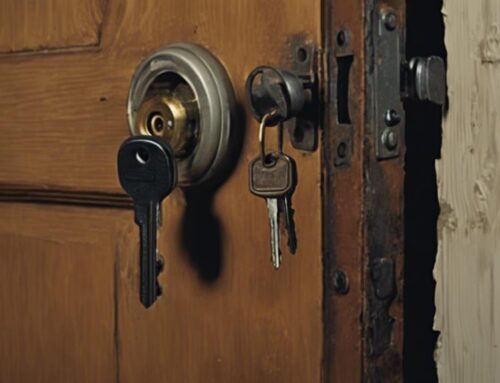Lock mechanics often fail due to common issues like worn pins, dirt accumulation, or misalignment. You can prevent these problems by regularly inspecting your locks and keys. Look for signs of wear, clean locks with compressed air, and lubricate them using a graphite-based lubricant. If you notice difficulty inserting the key or turning the lock, it may indicate pin wear or misalignment. Consider repairing worn keys or seeking professional help for persistent issues. By staying proactive, you can enhance your lock's longevity and security. There's more to explore on effective techniques and overall maintenance strategies.
Key Takeaways
- Regularly inspect and clean locks to prevent dirt buildup and ensure smooth operation; use graphite-based lubricant for best results.
- Monitor key wear and replace keys showing signs of damage, such as scratches and difficulty inserting, to avoid lock damage.
- Address common pin misalignment issues by ensuring proper installation and maintaining cleanliness to enhance lock functionality.
- Prevent rust and corrosion by keeping locks dry and rinsing them after exposure to salt or moisture.
- For effective repairs, lubricate locks, tighten screws, realign components, and replace worn parts; seek professional help if issues persist.
Understanding Pins and Tumblers
Most locks you encounter use a system of pins and tumblers, which play an important role in their security. These small components work together to guarantee that only the correct key can engage the lock, preventing unauthorized access.
Understanding how these components work can help you identify and address common lock problems. When the pins and tumblers fail, it often leads to frustrating situations where a key won't turn or, worse yet, a lock becomes completely inoperable. These failures can stem from dirt buildup, wear and tear, or even a lack of lubrication, which can disrupt the delicate balance necessary for proper operation.
Regularly cleaning and maintaining the lock can prevent such issues, as understanding lock mechanics is vital for effective upkeep.
When you're serving others, it's vital to guarantee their locks function smoothly. You can start by regularly maintaining locks to prevent issues. Clean the lock and apply a suitable lubricant to keep the pins moving freely.
If you encounter pins and tumblers failures, don't hesitate to take action. Repairing lock mechanics might involve disassembling the lock to replace worn-out parts.
Common Pin Misalignment Issues
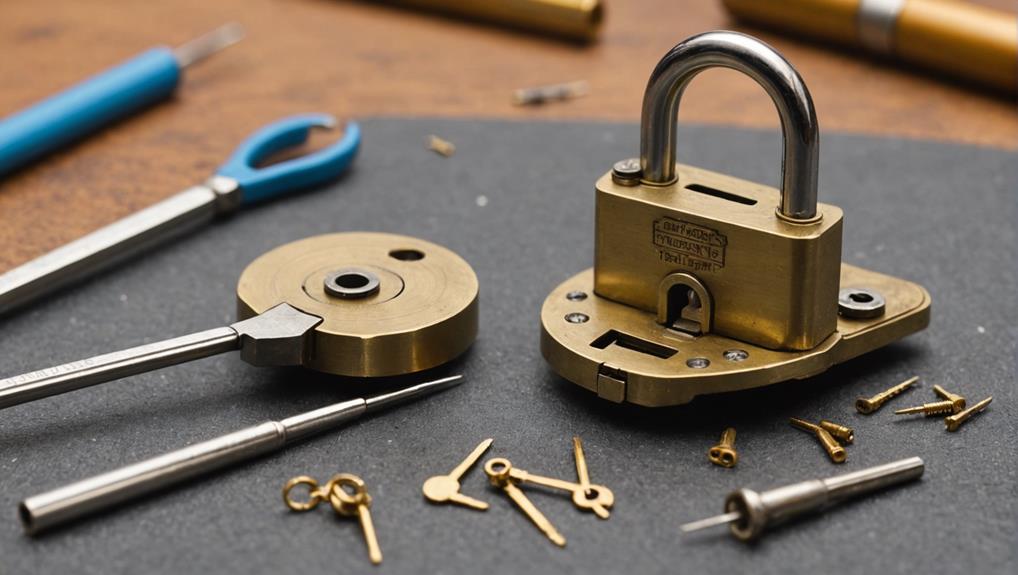
Common Pin Misalignment Issues
Misalignment of pins can create significant challenges for lock functionality. When pins don't align correctly, your lock may fail to engage or disengage, leading to frustration and security concerns.
To help you prevent lock mechanical failures, here are some common misalignment issues to watch for:
- Improper installation: Confirm the lock is fitted correctly in the door, as misalignment during installation is a common issue. Proper installation can also help avoid the need for lock re-keying services, which can be a convenient solution in case of malfunction.
- Debris buildup: Dirt or grime can obstruct pin movement, so keeping your lock clean is essential for smooth operation.
- Wear and tear: Over time, components may warp or degrade, causing misalignment that can impact lock performance.
- Temperature fluctuations: Extreme heat or cold can cause materials to expand or contract, leading to misaligned pins.
- Using the wrong key: Inserting an incorrect key can force pins out of alignment, damaging the lock and reducing its lifespan.
Worn Pins and Their Effects
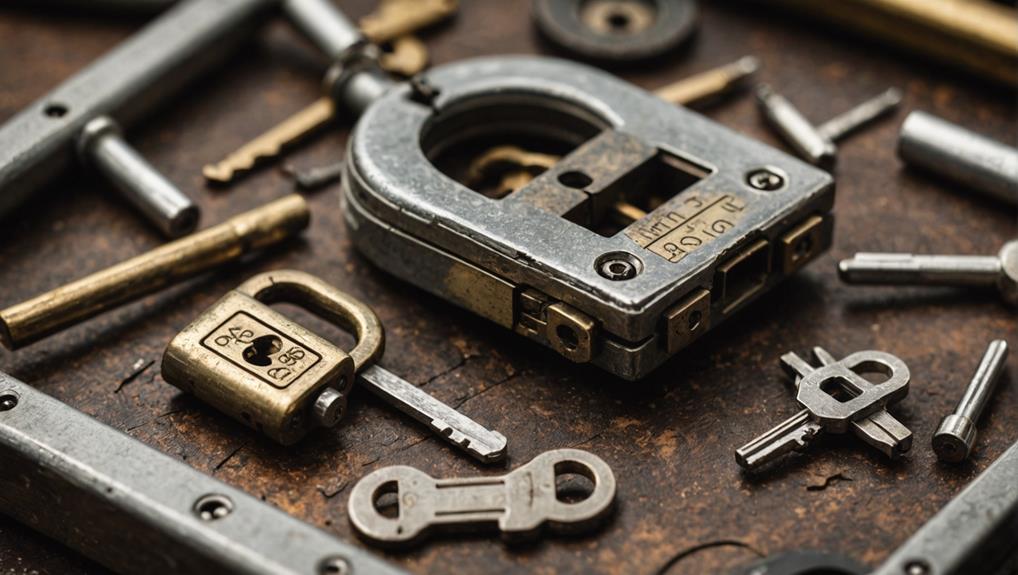
Worn pins can considerably compromise your lock's security and functionality. When pins become worn, they lose their ability to engage properly with the lock cylinder, making it easier for unauthorized access. This manipulation of the lock's tumblers can notably increase the risk of lock picking or forced entry, as detailed in understanding tumblers.
You might notice that your lock isn't turning smoothly, or it may even get stuck completely. These issues signal that the pins need attention.
If you're helping others maintain their locks, it's crucial to be vigilant about worn pins. Regular inspections can catch these problems early, allowing for prompt replacement. By doing so, you not only enhance the security of the lock but also prolong its lifespan.
When worn pins are left unaddressed, they can lead to more serious issues, including complete lock failure. This can leave someone vulnerable and feeling unsafe.
Encouraging those you serve to be proactive about lock maintenance can considerably enhance their security. Remind them that even simple, routine check-ups can save them from the inconvenience and potential danger of a malfunctioning lock.
Debris Accumulation in Locks
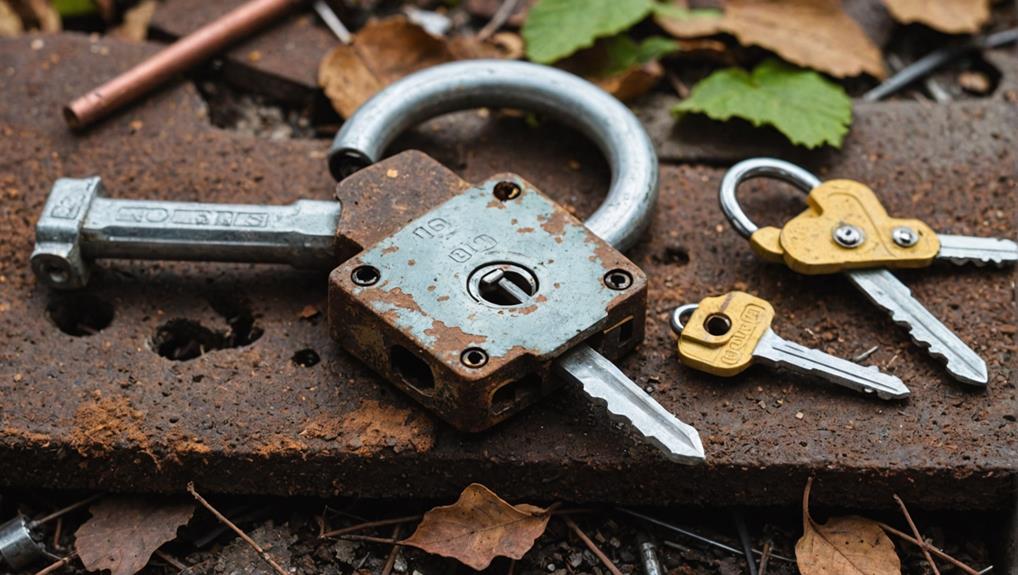
As you use your locks daily, debris can accumulate inside, hindering their performance. This buildup can lead to frustrating malfunctions, making your locks less reliable and secure.
To keep your locks functioning smoothly, it's crucial to address debris accumulation regularly. Mastering Sticking Locks involves understanding how to prevent and fix these issues. Here are some common types of debris to be aware of:
- Dust and Dirt: Ordinary particles can enter locks, especially in high-traffic areas.
- Lint: From pockets or bags, lint can get trapped inside, causing issues.
- Moisture: Even minimal moisture can attract and hold particles, exacerbating problems.
- Pet Hair: If you have pets, their hair can find its way into locks, causing blockages.
- Foreign Objects: Small items like paper clips or bits of plastic can accidentally enter.
To prevent debris buildup, regularly clean your locks by using compressed air to blow out particles.
Additionally, applying a small amount of lock lubricant can help keep moving parts clear.
By staying proactive, you guarantee your locks remain reliable, enhancing security for yourself and others.
Regular maintenance makes a significant difference, providing peace of mind for everyone who relies on your locks.
Rust and Corrosion Problems
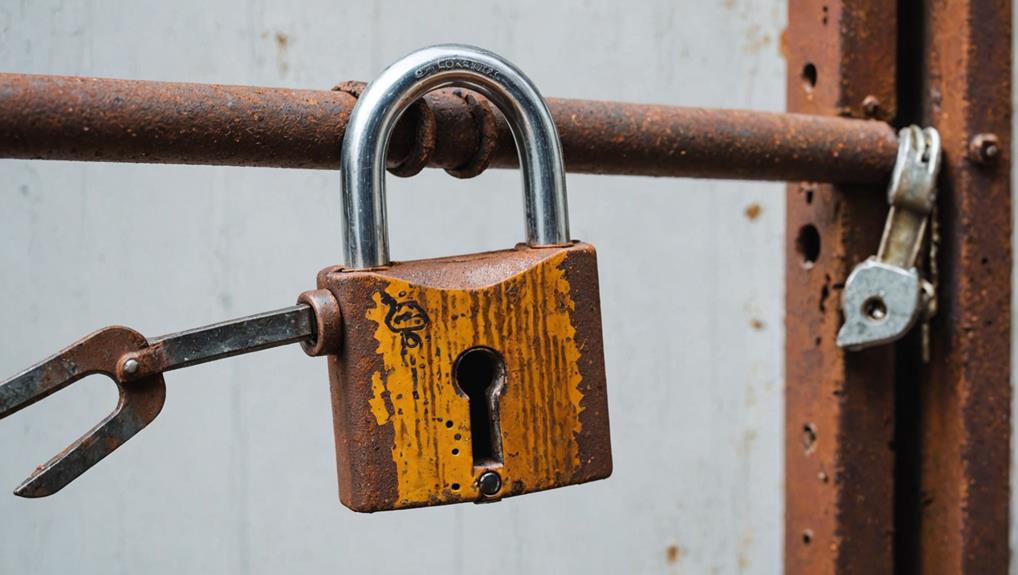
Locks are essential for security, but rust and corrosion can severely compromise their effectiveness. When moisture and air come into contact with metal, oxidation occurs, leading to rust. This not only affects the lock's appearance but also its functionality. To serve others better, you should be proactive in preventing these issues.
Here's a quick guide to help you understand rust and corrosion problems:
| Problem Type | Symptoms | Prevention Tips |
|---|---|---|
| Surface Rust | Discoloration | Regular cleaning |
| Pitting Corrosion | Small holes in metal | Apply protective coatings |
| Galvanic Corrosion | Deterioration near dissimilar metals | Choose compatible materials |
| Corrosion from Salt | Accelerated wear | Rinse locks in fresh water after exposure |
| Environmental Factors | Increased rusting | Store locks in dry places |
Key Wear and Tear
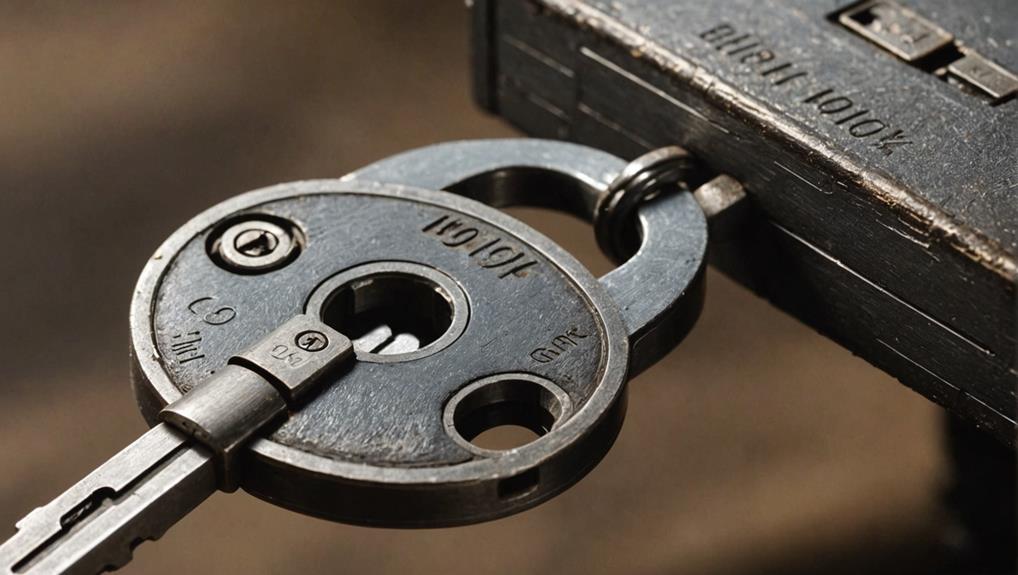
Over time, you might notice signs of wear on your keys, like scratches or difficulty turning in locks. Regular maintenance can extend their lifespan, but knowing when to repair or replace them is vital.
Utilizing proper tools and techniques for lock re-keying can help you address issues effectively, as outlined in essential tools for lock re-keying.
Let's explore how to identify wear, maintain your keys, and address any damage effectively.
Signs of Key Wear
When you frequently use a key, it's only natural for signs of wear to start appearing. Recognizing these signs early can help you prevent further damage to your lock and guarantee smooth operation.
Here are some key indicators that your key may be wearing out:
- Visible Scratches: Look for noticeable scratches or grooves along the key's surface.
- Worn Edges: If the edges of your key feel smooth or rounded instead of sharp, it's time for a replacement.
- Difficulty Inserting: Struggling to insert your key into the lock can signal that it's losing its fitting shape.
- Sticking or Jamming: If your key gets stuck or jams frequently, it could indicate wear that affects its performance.
- Noisy Operation: Unusual sounds when turning the key can mean it's not engaging properly with the lock mechanism.
Recognizing these signs early can save you from being locked out or damaging your lock.
If you notice any of these issues, consider replacing your key promptly for the best results in maintaining the integrity of your locks.
Maintenance Tips for Longevity
Maintaining your keys and locks is essential for ensuring they last as long as possible, especially after you've noticed signs of key wear. Regularly inspect your keys for any damage or rough edges. If you spot wear, consider replacing them sooner rather than later to prevent further issues.
Cleaning your keys is another important step. Wipe them with a soft cloth to remove dirt and grime that can cause friction and wear over time. You might also want to apply a tiny amount of lubricant to your locks, ensuring they're operating smoothly. Use a graphite-based lubricant instead of oil, as oil can attract dust and debris.
Additionally, avoid using excessive force when inserting or turning your keys. This practice not only prolongs the life of your keys but also protects your locks from unnecessary strain.
If you're helping others with their locks, remind them to be gentle too.
Repairing Worn Keys
Repairing worn keys is essential to maintaining their functionality and ensuring your locks operate smoothly. When keys start to show signs of wear, it can lead to frustrating moments and potential security risks.
Here are some steps you can take to repair and rejuvenate your keys:
- Inspect the key: Look for visible signs of wear, such as scratches or bent edges.
- File down rough edges: Use a fine file to gently smooth out any jagged areas on the key's surface.
- Clean the key: Wipe it down with a soft cloth to remove dirt and grime that could affect its performance.
- Test the key: Insert it into the lock to check for any sticking or jamming; if it still doesn't work smoothly, consider further repair options.
- Consider duplication: If the key remains problematic, getting a new copy made can be a quick and effective solution.
Improper Key Insertion
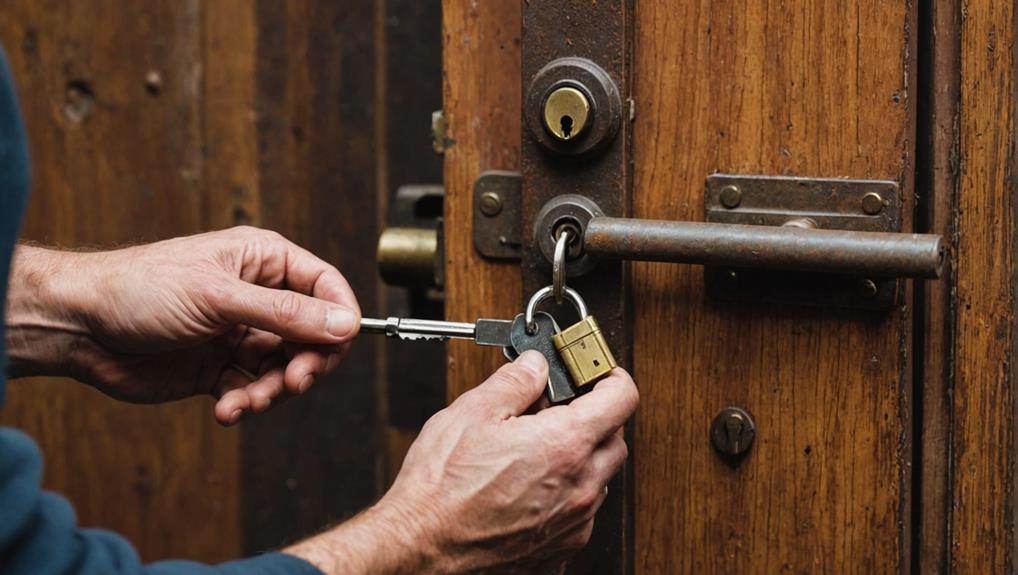
Improper key insertion can lead to several frustrating issues, from key alignment problems to worn key teeth.
If your key isn't sliding in smoothly, it might be a sign of lock cylinder misalignment. Additionally, this could be an early warning sign that your lock is nearing the end of its lifespan, as common warning signs can indicate the need for replacement.
Recognizing these signs early can save you from more serious lock malfunctions down the line.
Key Alignment Issues
Inserting a key at the wrong angle can lead to frustrating alignment issues that prevent your lock from turning smoothly.
When you encounter this problem, it's crucial to understand the common causes so you can assist others effectively. Here are some factors contributing to key alignment issues:
- Key Orientation: Verify the key is inserted with the correct side facing up.
- Debris in the Lock: Dust or dirt can obstruct the keyway, causing misalignment.
- Worn or Damaged Keyway: Over time, the internal components may wear, affecting key insertion.
- Incorrect Key Size: Using a key that's too big or too small can hinder proper alignment.
- Lock Cylinder Damage: A damaged cylinder can misalign the mechanism, preventing smooth operation.
Worn Key Teeth
Key misalignment can often stem from worn key teeth, which can prevent the key from engaging with the lock properly. When you insert a key with worn-down teeth, it might not fit snugly, leading to frustration and potential damage to both the key and the lock. Identifying the signs of wear can help you address the issue before it escalates.
| Signs of Worn Key Teeth | Recommended Actions |
|---|---|
| Difficulty inserting the key | Inspect the key for wear |
| Key feels loose in the lock | Replace the key if needed |
| Lock doesn't turn smoothly | Lubricate the lock mechanism |
| Visible damage on key teeth | Get a duplicate key made |
| Frequent jamming | Consult a locksmith |
To prevent further complications, consider replacing worn keys promptly. Keeping a spare key handy can also save you time and stress. By being proactive, you not only maintain your locks but also provide peace of mind for those depending on your services. Remember, a well-maintained key guarantees smooth operation and longevity for your locks.
Lock Cylinder Misalignment
A slight misalignment in the lock cylinder can lead to frustrating issues when you're trying to insert your key. You may find yourself jiggling the key or even forcing it, which can cause further damage to your lock.
Understanding the causes and solutions can help you serve others better by confirming their locks function smoothly.
Here are some common signs of lock cylinder misalignment:
- Difficulty inserting or turning the key
- Key getting stuck or feeling loose
- Inconsistent locking or revealing
- Visible gaps between the lock and door
- A rattling sound when the key is inserted
To prevent and repair lock cylinder misalignment, consider these steps: first, check for obstructions around the cylinder.
Second, verify the screws holding the lock in place are tightened properly.
Third, if the door is warped, adjust the hinges.
Fourth, lubricate the lock with graphite to enhance functionality.
Regular Maintenance Practices
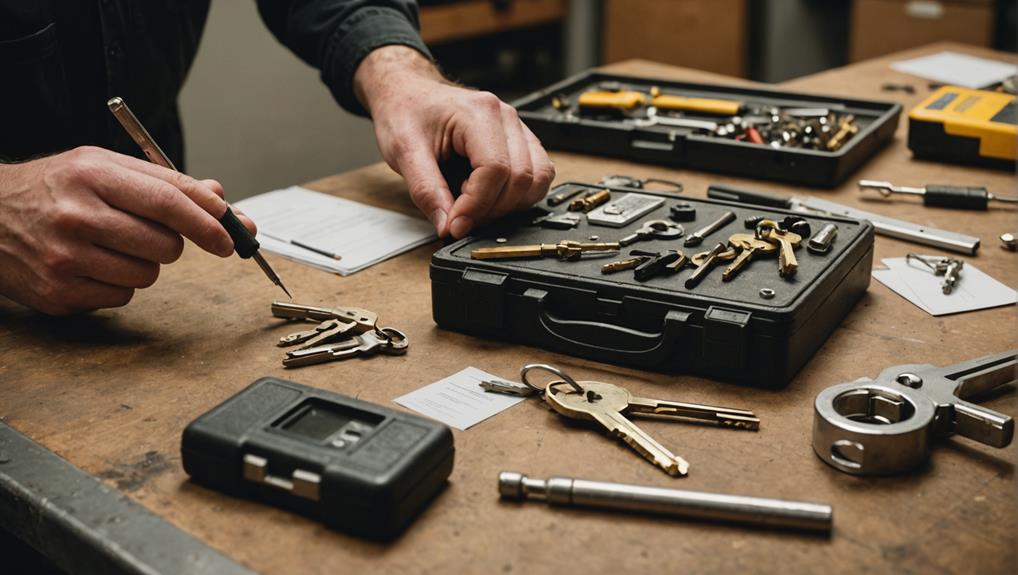
Regular maintenance practices are crucial for keeping your locks functioning smoothly and securely over time. Start by regularly inspecting each lock for signs of wear or damage. Look for rust, corrosion, or any misalignment that could hinder performance. If you notice anything unusual, take action before it leads to bigger problems.
Additionally, consider the type of lock you have; different locks may require specific maintenance approaches, as highlighted in lock replacement options.
Next, lubricate your locks periodically with a graphite-based lubricant. Avoid using oil-based products, as they can attract dirt and debris, which can cause more harm than good. Apply the lubricant directly into the keyhole and operate the lock a few times to distribute it evenly.
Cleaning is another crucial aspect of maintenance. Use a soft cloth to wipe away any dust or grime around the lock, maintaining it clear and functional.
Lastly, confirm that your keys are in good condition. Bent or damaged keys can cause unnecessary strain on the lock mechanism, potentially leading to failure.
Effective Repair Techniques
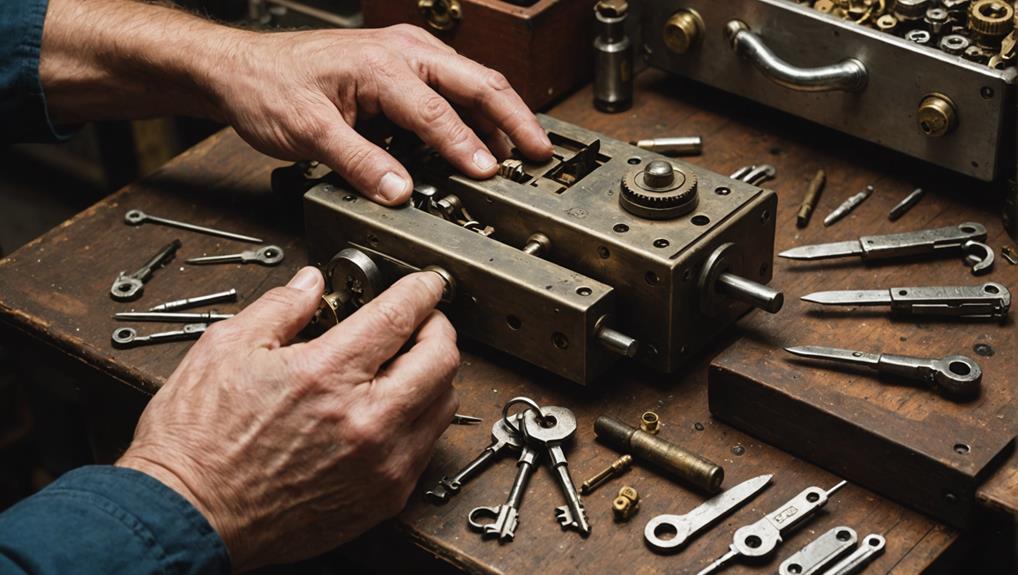
Many homeowners encounter lock issues at some point, making it essential to know effective repair techniques.
When you face a lock malfunction, addressing it swiftly can prevent more significant problems down the line.
Here are some techniques you can employ to repair common lock issues:
- Lubricate the Lock: Use graphite powder or a silicone-based lubricant to guarantee smooth operation.
- Tighten Loose Screws: Check and tighten any screws on the lock mechanism; they often loosen over time.
- Realign the Strike Plate: If the lock doesn't align properly, adjust the strike plate to guarantee the bolt engages correctly.
- Replace Worn Parts: Identify any worn-out components like springs or tumblers and replace them to restore functionality.
- Seek Professional Help: If the issue persists, don't hesitate to consult a locksmith who can provide expert assistance.
Frequently Asked Questions
How Can I Tell if My Lock Is Damaged Beyond Repair?
To tell if your lock's damaged beyond repair, start by inspecting for visible signs like rust, cracks, or missing parts.
If you notice the key won't turn smoothly or the lock feels loose, it might be time to replace it.
Listen for unusual noises when you use it; they can indicate internal damage.
If the lock frequently jams or requires excessive force, it's likely time to contemplate a new one for safety.
Are There Any Signs That Indicate a Lock Needs Professional Servicing?
Isn't it amusing how you often ignore the little signs your lock throws at you?
If it's sticking, making odd noises, or refusing to turn smoothly, it's time to reflect on professional servicing.
You might think it's just a quirk, but these issues can lead to bigger problems.
Trust your instincts, and don't wait until you're locked out.
Caring for your lock now means serving your future self with peace of mind.
What Tools Do Locksmiths Use for Lock Repairs?
Locksmiths use various tools for lock repairs, ensuring your security is maintained.
They often rely on tension wrenches, picks, and screwdrivers to manipulate and disassemble locks.
You might see them using plug spinners and key extractors to handle specific issues.
With specialized tools like lock bypass tools, they can effectively address more complicated problems.
How Often Should I Replace My Locks for Security Reasons?
You mightn't realize it, but your locks could be the silent guardians of your home.
To keep your security strong, consider replacing your locks every 5 to 7 years. If you've moved into a new place or lost a key, it's wise to change them sooner.
Regularly check for wear and tear, and don't hesitate to upgrade to more advanced locks for added protection.
After all, peace of mind is priceless.
Can I Fix a Lock Myself Without Professional Help?
Yes, you can fix a lock yourself without professional help, but it depends on the issue.
If it's something simple like a stuck key or a misaligned strike plate, you can often resolve it with basic tools.
However, if the lock's internal mechanisms are damaged, you might want to reconsider.
Always guarantee you have the right parts and instructions before starting, and don't hesitate to call a locksmith if you feel uncertain.
Conclusion
In summary, keeping your locks in top shape is essential to avoid common failures. Did you know that nearly 30% of lock issues arise from simple maintenance neglect? By regularly checking for pin misalignment, debris, and rust, you can prevent most problems before they escalate. Plus, a little routine care not only extends your lock's lifespan but also enhances your security. So, take a few minutes to maintain your locks, and you'll save yourself time and hassle down the road!

